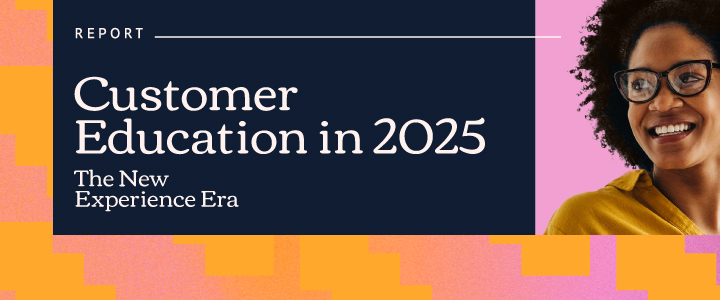
5 min reading time
Keeping Customers Engaged: How Education Drives Retention and Reduces Support Demand
What you’ll learn
The Engage stage of the customer lifecycle helps support teams go from putting out fires to building the kind of proactive experiences that drive customer success. It reduces support friction, boosts adoption, and drives long-term loyalty.
- Customers resolve issues faster through self-service, microlearning, and in-product education.
- Support teams gain time to focus on strategic, high-impact tasks like integrations and escalations.
- Engage-stage education reduces repetitive support tickets and improves efficiency.
- Satisfaction, retention, and NPS rise as customers see more value from the product.
- Measurable outcomes—like ticket volume, adoption, and retention—prove the business impact of customer education.
Imagine Tom, a Customer Support Manager, spending his days buried under repetitive support tickets. He barely has time to analyze usage data and spot churn risk before it happens—let alone tackle complex issues like integrations or technical escalations. Keeping satisfaction and NPS high feels almost impossible.
Sounds like a nightmare, right? It doesn’t have to be this way. With the right customer education strategy at the Engage stage—following Activate in LearnUpon’s framework that connects education initiatives to each step of the customer lifecycle—Tom and his team are able to shift from reactive firefighting, to proactive customer support.
And it’s not just theory: 93% of organizations increased investment in customer education last year, while 92% anticipate future growth in their programs. That kind of momentum can’t be a coincidence.
The Role of Engage in the Customer Lifecycle
Let’s step back for a moment: what is the Engage stage, and why does it matter? For 44% of organisations, the primary goal of their customer education program is customer support. And there’s a reason this number is so high.
While Attract turns prospects into customers and Activate gets them started, Engage is what keeps them moving forward. Here, the focus is on:
- Reducing support friction
- Boosting feature adoption
- Increasing satisfaction and retention
For Tom, this means empowering customers to find answers on their own, freeing up time for his team to work on strategic initiatives. Success at this stage also sets the scene for what comes next in the Grow phase, where the focus shifts to upsells and advocacy.
The Friction Holding Customers Back
Sarah, one of Tom’s customers, is trying to use a new reporting feature. After clicking through three menus, she still can’t find the answers she needs, so she opens a support ticket. Even when support responds quickly, by the time they reach her, frustration has already set in. And that feeling won’t stay confined to one feature; it affects how she sees the product overall.
This scenario creates more than one challenge. Sarah hasn’t learned how to use the new feature, and she’s left frustrated with the product. As a result, her view of its full value is limited.
For Tom, it’s another support ticket on his endless list, while other issues pile up. This isn’t a one-off bad customer experience; it’s a lost opportunity for both the customer and the business.
From Support Tickets to Self-Service: Seamless Experiences That Deepen Customer Relationships
From Tom and his team’s experience, the solution is clear: scalable, efficient learning experiences that keep customers engaged, while also strengthening relationships. These experiences guide customers step-by-step, helping them solve problems on their own and only turn to support as a last resort. Examples of Engage-stage education include:
- Role-Based Learning Journeys through a Customer Academy: Tailored to each role, these learning journeys provide relevant, personalized content at scale, helping customers adopt features faster.
- Self-Serve Knowledge Bases: Instead of immediately raising a ticket, customers can find solutions on their own, without needing hand-holding from Tom’s team.
- Microlearning: Short, focused modules—quick tutorials or step-by-step guides—let customers learn specific features or tasks without committing large chunks of time, keeping education digestible.
- In-Product Learning: In-app messages, tooltips, and prompts guide customers exactly when and where they need it, driving adoption and engagement naturally.
- Community & Peer Learning: Communities encourage knowledge sharing between customers, which not only reduces support tickets but also builds engagement and loyalty.
Real-World Example: How gWorks Reduced Support Tickets by 18%
gWorks, serving over 2,500 local government agencies, faced repetitive support tickets and a small support team. By launching a customer academy with role-based learning paths, users found answers on their own and adopted features faster. The result? Support tickets dropped by 18%, while customer confidence and engagement grew—showing the impact of a smart Engage-stage strategy.
The Internal Impact: Turning Support Teams into Strategic Partners
Once Engage-stage strategies are in place, the scenario changes not just for Sarah—now empowered to find answers on her own—but also for Tom’s team.
The endless treadmill of support tickets slows down, freeing up more time than ever to focus on strategic, high-impact tasks. Now, they focus on complex cases like integrations and escalations, and these real customer interactions allow them to provide valuable insights back to Product and Customer Success teams.
On top of that, Tom’s team can dedicate time to upskilling, optimizing tools, and refining processes, so when customers do need support, they’re faster, smarter, and more effective than ever. The Engage stage isn’t solely about helping customers. It transforms the internal team into a proactive, strategic force.
Numbers That Matter: Measuring and Growing Engagement
You can’t improve what you can’t prove. So for Tom to keep momentum going and secure leadership buy-in for Engage-stage strategies, he needs to show results from the approaches now part of customer education—from self-serve knowledge bases and role-based learning paths to microlearning modules and in-product nudges. He knows that 38% of organisations experience difficulty in isolating the impact of education from other factors, and he doesn’t want to be part of this statistic.
With this in mind, Tom gathers the follow customer-facing metrics to prove the success of the new customer education strategies:
- Support Ticket Volume: Fewer repetitive tickets indicate customers are finding answers on their own, so they don’t need a support team member to come for the rescue.
- Product Usage & Feature Adoption: When product usage and feature adoption numbers increase after implementing Engage-stage strategies, it’s easy to correlate the improvements with the education initiatives.
- Customer Satisfaction (CSAT/NPS): By monitoring CSAT and NPS, Tom can track changes in customer sentiment and clearly link improvements to the new Engage-stage strategies. This shows leadership that education isn’t just reducing tickets—it’s actively boosting satisfaction and loyalty.
- Retention & Churn Rates: As retention climbs and churn declines, Tom can link feature adoption and ongoing education to sustained customer loyalty—a concrete sign that Engage-stage strategies are working in practice.
But as Tom knows well, the Engage stage impacts customers just as much as it benefits internal teams. Internal Operational metrics also play a key role in demonstrating the efficiency and effectiveness of the customer education strategies:
- Time Saved for Support Teams: By comparing the amount of time spent with support tickets before and after the Engage-stage strategies have been implemented, Tom can showcase the amount of freed-up time for strategic tasks.
- Efficiency of Education Delivery: Tom can tell if customers are actually leveraging the strategies by tracking engagement. Metrics like the percentage of users completing learning paths, interacting with microlearning modules, or using self-serve resources show whether the content is being adopted, and also highlight opportunities to optimize and improve the learning experience.
By gathering these impact results, Tom ensures every Engage initiative contributes to ongoing customer value and satisfaction, preparing customers for the Grow stage.
From Engagement to Growth: Turning Learning into Impact
Investing in the Engage stage isn’t just a support play, but a strategic lever that drives adoption, satisfaction, and long-term growth across the entire customer lifecycle.
Next comes Grow, the stage where customers become super users who drive advocacy and revenue. Just like in the previous customer lifecycle stages, a successful Engage stage lays the foundation for the following one, ensuring customers reach that point highly satisfied and fully empowered.
Want to see how customer education drives value across the lifecycle? Download our whitepaper, Customer Education in 2025, for the latest trends, strategies, and insights shaping education-led growth.



